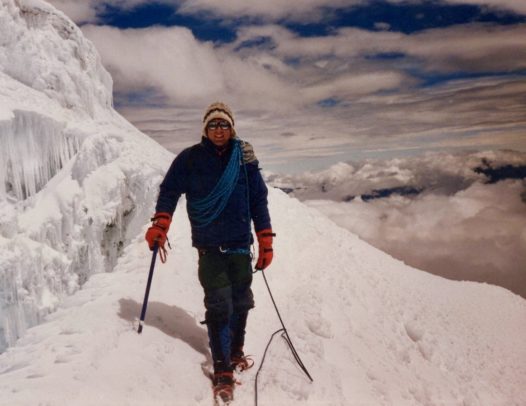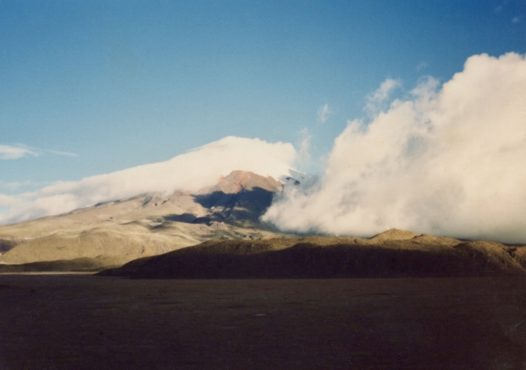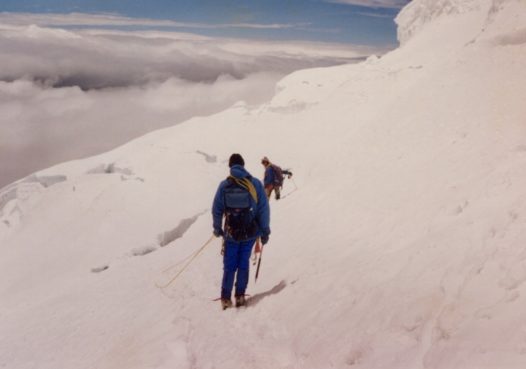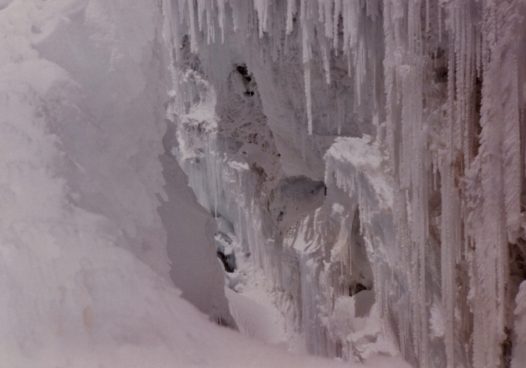
Paul on Cotopaxi (photos by: Folwell Dunbar)
In the Armpit of the Pacific*
“The ceviche smells fishy,” I said.
“Of course it smells fishy, Sherlock,” said Mike. “It’s &%$#ing FISH!”
“I know,” I said, “but it just doesn’t seem right.”
“Dude, we’re on the &%$#ing beach,” he said. “It’s gotta be fresh!” Mike took a small bite, rolled the lime-cooked flesh over his tongue, winced and spit it out on the sand. “OK, maybe you’re right…”
We were in the seaside town of Esmeraldas on the Pacific coast of Ecuador. According to Lonely Planet, “Esmeraldas is ugly, dangerous and dirty, and there’s really no reason to stay there.” Yet, there we were.
Mike and I were on our Christmas Break from the Peace Corps. We were looking to experience “the real” Ecuador, warts and all. Esmeraldas seemed as good a place as any.
Later that night, I heard a grumbling from the top bunk. I figured either Mike had gotten “lucky” at a chongo, or he had had one too many tragos. Then, I heard a visceral bellow and the bed suddenly lifted to one side.
I looked up and caught Mike’s silhouette sailing through the air like a flying squirrel that had misjudged the distance between two tree limbs. Midway to the floor, Mike violently exploded, spraying shrapnel in all directions, including mine. When he hit the dirt floor of our palapa, he was almost completely devoid of liquid. Lying in a shallow pool of his own plasma, he murmured, “Yeah, the ceviche was definitely bad!”
Mike spent the rest of the evening in a public latrine down the beach.
The next morning, two friends of ours arrived by bus from Santo Domingo. Paul and Steve were looking forward to a few days of sun, sand and cerveza. Unlike us, they envisioned Spring Break in Fort Lauderdale, Cancun or Montego Bay. After a quick survey of the gritty oil and banana port town though, their “Girls Gone Wild” bubble burst.
“This place is the f%&ing armpit of the Pacific,” said Steve. “There’s no way I’m spending my vacation here!”
“Let’s climb Cotopaxi instead,” suggested Paul. Paul was from Colorado and was an avid mountaineer. His fourth** Peace Corps goal was to climb every major peak in the country.
“I’m in,” said Steve.
“Sounds like an adventure,” I said. “¿Por qué no? Why not?” Note: “In retrospect, “adventure” was a gross understatement and the answer(s) to my rhetorical question was patently obvious.
Mike, still a bit green from the ceviche, shrugged and said, “No, not me. I’d rather recover from food poisoning here; the air is warm and the beer is cold. I’m staying in “the f%&ing armpit!”
The Ascent into Madness
The next morning, the three of us jumped on a bus to Quito and climbed more than 9,000 feet up into the high Andes. In Ecuador’s capital, we borrowed sweaters, jackets and sleeping bags from volunteers in the city, and we rented climbing equipment: gaiters, crampons, carabiners, ice axes, and other gear I had only seen in movies and magazines. We then hired a driver to take us to the Jose F. Rivas refuge on the northern flanks of Volcán Cotopaxi, the tallest active volcano in the world.
On the ride up, Paul asked, “Have you ever been mountaineering?”
“Are you kidding?” I said. “I’m from Louisiana. Our highest peak is Mount Driskill, which, technically, isn’t even a mountain. The levees and Monkey Hill are about as high as you get in New Orleans.”
Two miles below the refuge, it started to rain. The dirt road quickly turned to mud and the driver abruptly stopped. “No puedo siguir,” He said. “I can’t continue. You’ll have to walk from here.” We grabbed our heavy packs and began slogging our way up the mountain.

Cotopaxi with the clouds rolling in (photos by: Folwell Dunbar)
A half an hour later, Steve began to cough and wheeze. He could hardly breathe. “My head feels like it’s in a vice,” he complained, as blood trickled from his nose. Steve was suffering from a severe case of altitude sickness. The climb from sea level to 15,000 feet in one day had obviously been too much.
Paul and I took turns carrying Steve’s pack. We arrived at the refuge just before dusk.
Our original plan was to spend at least one full day at the refuge acclimating to the high altitude. Now, we figured we’d have to take Steve back to Quito as soon as possible.
Steve, in addition to feeling bad, felt guilty. “Why don’t you guys try to summit tonight?” he suggested. “You’d be back by 8:00. We could return to the city then. Who knows, I might even recover…”
“Is it safe to climb at night?” I asked.
“You have to climb at night,” said Paul. “Cotopaxi is almost on the Equator. The intense heat from the sun during the day melts the snow and makes it too dangerous to climb. You try to summit by daybreak, enjoy the view at the top, and then hustle back down before the snow turns to sludge. I’m up for it if you are?”
Again, I foolishly replied, “¿Por qué no?”
Though almost 20,000 feet above sea level, Cotopaxi is actually not a difficult climb. In 1802, the famous explorer, Alexander von Humboldt almost made it to the top without the benefit of fancy gear like carabiners or Patagonia goose down. “For an experienced climber under good conditions,” said Paul, “it’s practically a walk in the park.” Unfortunately for me, neither of those was the case.
That night, we hung out with other climbers. We drank shots of warm canelazo, an Ecuadorian version of a hot toddy made with aguardiente or burning water, and we ate locro de papas, a traditional Andean soup from a communal pot.
In a sleeping bag obviously rated for milder temperatures, I spent the next four hours shivering – and awake.
At midnight, a group of about thirty climbers (and me) left the refuge. When we reached the edge of the glacier, we stopped to put on our crampons, tie in with other “mountaineers,” and discuss the route. Paul used the opportunity to show me a few techniques, including the all-important self-arrest. “You probably won’t need this on Cotopaxi,” he assured me, “but, it could save your life some day…”
I used the opportunity to contemplate the meaning of the word, “probably” and the idea that people actually die while climbing mountains.
As soon as we got up on the ice, the winds picked up and snow began to fall. Soon, we were in an all-out blizzard. Visibility dropped to zero, and half the climbers wisely turned around. Paul and I stubbornly soldiered on.
Inching my way up in the darkness, my lungs began to seize up. I couldn’t find the air. After every step, I had to stop and gasp for breath. I was like a fish in a stagnant pool desperately gulping at the surface.
Progress was painfully slow. I could sense my teammate’s growing frustration. Like a massive barnacle on the bottom of a racing shell, I was holding them back. At this pace, we’d summit by Easter.
As we came upon a small cave on the side of the mountain, I said, “Y’all go on without me. I’ll stay here and y’all can pick me up on the way down.”
“You sure?” asked Paul, a bit guilty but also relieved.
“Por supuesto, of course,” I lied.
Like the parents of Pierre in that cautionary tale by Maurice Sendak, “they left me there.”
I crawled inside the cave, curled up in the fetal position and nursed (unsuccessfully) on thin air.

Above the clouds on Cotopaxi (photos by: Folwell Dunbar)
In my snowbound mausoleum, I thought about George Mallory on Everest, Sr. Ernest Shackleton’s ill-fated expedition to the South Pole on the Endurance, the Uruguayan rugby team that crashed in the Andes and ate each other to stay Alive, the protagonist in that famous short story by Jack London, and Jeremiah Johnson, who catches on fire sleeping on hot coals. I tried to think of other things, more pleasant things, but I couldn’t. My brain cells, deprived of oxygen, were in their own state of “self-arrest!”
My grim hallucinations soon morphed into a full-blown panic attach. I had no one to eat, no bed of coals to sleep on, no Sherpa to retrieve my body, nor dog to grieve my death. I was gonna die alone in a cave on the side of the world’s tallest active volcano!
So, I picked myself up and resumed the ascent – into madness…
A few hundred yards below the volcano’s crater, I ran into my team on its way down. They berated me for leaving the cave and climbing without a rope. But, I could tell they were also reasonably impressed. “He made it this far,” said one of the climbers. “He deserves to summit.”
“It’s getting late,” cautioned Paul, “but I agree. Let’s give him a shot.”
It was well after 8:00 o’clock when I finally reached the summit. They say on a clear day atop Cotopaxi, you can see both the Caribbean Sea and the Pacific Ocean. In the blinding sleet, I could hardly see my own frozen feet. Like Chevy Chase at the Grand Canyon in National Lampoon’s Vacation, I looked over the edge, bobbed my head up and down and said, “OK, let’s go.”
Hanging from a Frayed Rope
In the confusion of the blizzard, we somehow missed the trailhead and came down off the wrong side of the mountain.
An hour later, we finally realized our mistake. We had two options: we could either climb back up or skirt around. The former would be longer and harder, while the latter would be technically more demanding but possibly quicker. Considering the clouds had passed and the equatorial sun was now cooking us like an Easy-Bake Oven, we opted for curtain number 2.
After more than 10 hours on the mountain, I could finally breathe. Now, I was just cold, tired and hungry.
“Make sure you keep your crampons clean,” warned Paul, whacking the bottom of his boots with the blunt end of his axe. “The snow is starting to melt!”
A few minutes later, having forgotten to clear my crampons, I took my first fall. I slipped on my ass and started tumbling down the side of the mountain. Remembering Paul’s earlier tutorial, I rolled onto my side and plowed my ice axe into the snow. When I came to a stop, my teammates applauded. Note: After my fourth fall, they stopped clapping and just stared at me with contempt.

The Crevasse (photos by: Folwell Dunbar)
At some point along the way, we came across a massive crevasse. (see picture) “We’ll have to build a snow bridge,” exclaimed Paul! Paul was excited because he had never done the maneuver; I was terrified because Paul had never done the maneuver.
As I crawled across the bottomless, icy canyon on a makeshift ladder, I looked down and discovered for the first time that I was Acrophobic. The timing of course could not have been worse. My climbing companions, por supuesto, found it both predictable and amusing!
It took a while, but we crossed the crevasse and continued our descent.
Finally, after more than 16 hours of climbing, we reached the edge of the glacier. Paul gave a stern warning, obviously directed at me, “Be careful, the ice is slick!”
Before the last syllable left his now chapped lips, my feet kicked up into the air and I fell flat on my chest. Like an Olympic skeleton racer, I flew down the side of the mountain. As I had done several times before, I rolled onto my side and leaned into my axe, causing a rooster tail of ice to arc up into the air behind me. But, I didn’t stop. Instead, I sailed off into the abyss.
The force and weight of my free-falling body yanked two other climbers down after me. Only Paul and one other remained. For a brief moment, they actually considered cutting us loose. Instead, they jammed their ice axes into the rock, dug in with their crampons and braced for impact.
Unlike a bungee cord, the rope had almost no elasticity. The jolt was, well, jarring. It caused me to drop my axe, compressed several vertebrae, and chipped my front tooth. I came to an abrupt stop and careened back into the hard rock face of Cotopaxi, ripping off a gaiter, tearing my borrowed down jacket, and smashing my nose. But, I was alive!
Hanging by a frayed rope like a corpse from the gallows, I thought to myself, “I’d rather be eating spoiled ceviche in the Armpit of the Pacific” and, “Thank God for frayed rope!”
Epilogue
It took us another hour and a half to get back on and off the glacier. By the time we finally made it back to the refuge, the sun was setting off the coast of Esmeraldas. We had been climbing for more than 18 hours straight!
Steve had already gone back to the city and had checked himself into the Peace Corps infirmary. Paul and I hitched a ride in the cab of a supply truck back to Quito. I slept at a hostel for two days before heading back to my site.
Paul told me he had never been on a climb where there had been so many falls. It was a dubious distinction and cold comfort,*** especially considering it cost me more than a month’s per diem to replace the equipment I had destroyed.
When I finished my stint in Cuerpo de Paz, I moved back to the flatlands of Louisiana. Apart from summiting an occasional levee, I haven’t climbed since!
* Esmeraldas is actually an interesting town. Settled by escaped slaves in the 16th century, it was one of the largest maroon communities in Spanish South America. Its residents developed a distinctive style of music called currulao and a popular coconut seafood stew called encocado. The city has also produced some of Ecuador’s finest football (soccer) players.
** Officially, there are only three Peace Corps goals: 1) to help the people of interested countries in meeting their need for trained men and women, 2) to help promote a better understanding of Americans on the part of the peoples served, and 3) to help promote a better understanding of other peoples on the part of Americans. If there were a fourth goal, it would be for volunteers to survive (and learn from) boneheaded decisions.
*** Speaking of cold comfort, whenever I play that team-building game where you have to list two truths and a lie, I always include “falling off the world’s tallest active volcano.”
Folwell Dunbar is an educator, artist and retired mountaineer. He can be reached in New Orleans, just above or slightly below sea level at fldunbar@icloud.com
 NOLAbeings Multimedia artist Claire Bangser created NOLAbeings as a portrait-based story project that marries...
NOLAbeings Multimedia artist Claire Bangser created NOLAbeings as a portrait-based story project that marries...  Voodoo in New Orleans: Reviving history: New Orleans fortune telling This article takes a deep dive into the history of Voodoo in New Orleans, its hybridization with Catholicism, and its present-day place in the city's culture. The author visits fortune-tellers in the French Quarter, using their guidance as a tool for introspection rather than a deterministic predictor of the future. Through her experiences in New Orleans, the author feels a mystical connection to both the past and the future.
Voodoo in New Orleans: Reviving history: New Orleans fortune telling This article takes a deep dive into the history of Voodoo in New Orleans, its hybridization with Catholicism, and its present-day place in the city's culture. The author visits fortune-tellers in the French Quarter, using their guidance as a tool for introspection rather than a deterministic predictor of the future. Through her experiences in New Orleans, the author feels a mystical connection to both the past and the future. 
[…] I have a stash of go-to truths – truths that conveniently sound a lot like lies. They include falling off the world’s tallest active volcano, being mistaken for the Colombian cocaine cartel kingpin, Pablo Escobar, and swallowing a huge live […]